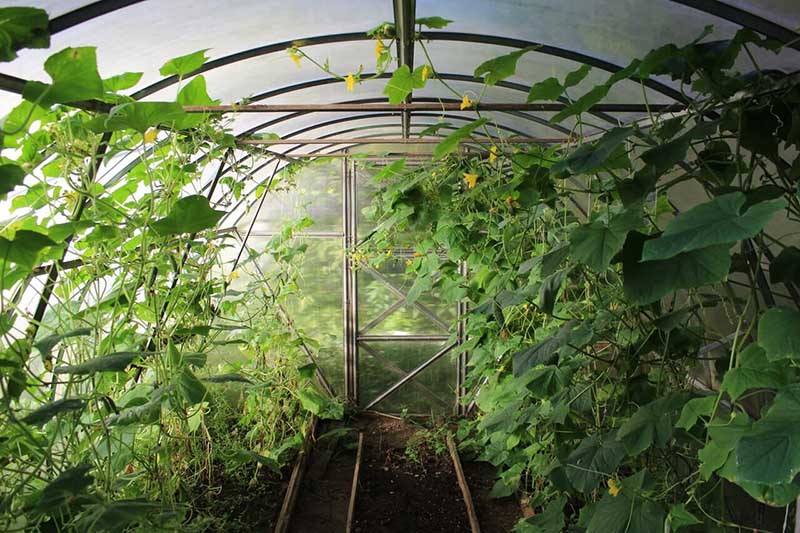Greenhouse gardening offers so many benefits, including an increase in crop yields. However, keeping your structure cool, especially in summer can be costly when using electric power. So, perhaps you would like to know how to cool a greenhouse without electricity?
Well, while there are many ways to keep temperatures down in your greenhouse without electricity, there is no one size fits all solution. For example, dampening down may not work for everybody because it is laborious. Fortunately, there are other methods available, like shading and the use of roll-up side curtains.
In this guide, you can find a list of the 10 best and most-effective ways to cool a greenhouse without electricity.
How To Cool A Greenhouse Without Electricity?
Cooling your greenhouse can be damn expensive when using electric power. The good news? If you are looking to save on costs, you will come across many methods of cooling a greenhouse without electricity.
1. Manual or solar-powered vents
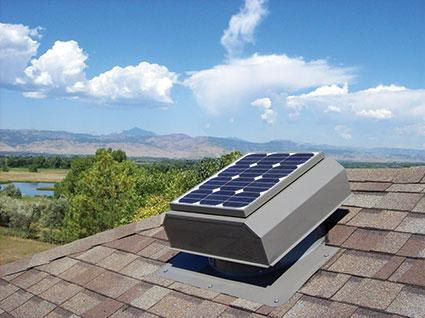
Most greenhouses come with pre-built roofs and side vents. This cooling method works in a way that as temperatures increase inside your greenhouse, the hot air rises to escape via the roof vents. Consequently, this generates a vacuum that pulls cooler air from outside into your structure via the side vents near the ground.
You just open the vents manually during the day to allow the excess heat to escape. Alternatively, you can install solar-powered vent openers to automate the whole process. You just ensure the number of vents in your garden equals 40% of your structure’s floor area.
2. Use of solar-powered fans
Solar-powered greenhouse fans come in two types, including exhaust and circulation fans. Exhaust fans work by removing hot air from your hothouse while circulation fans distribute air inside the greenhouse. This helps ensure uniform indoor temperatures.
For the best results, you should mount the exhaust fans on the wall towards the roof of your structure. On the other hand, you can place the circulation fans on the floor close to the center of the air mass. As for the number of fans you need, they should be around twice the floor area of your greenhouse.
3. Shading
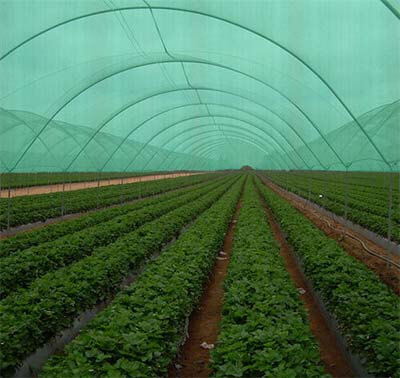
Shading helps block incoming solar radiation, bringing greenhouse temperatures down. You could use a shade cloth, shade paint, or shade blinds. Overall, greenhouse shade cloth is the best to use because it’s easy to install and inexpensive.
Shade blinds are relatively expensive, and you can fit them inside or outside your greenhouse. As for shade paint, you simply apply paint to the exterior of your greenhouse to filter out sun rays. However, you cannot use shade paint on polycarbonate or natural wood-made structures.
4. Wetting greenhouse surfaces
This simple DIY cooling method involves damping down hard surfaces in your greenhouse, including stone paths, walls, and shelves. You simply use a hose pipe to wet all surfaces throughout the day.
So then, how does it work? Wetting or damping down helps raise the moisture levels in your structure as the water dissipates from the hard surfaces. As a result, this keeps your greenhouse cool.
5. Misting or fogging systems
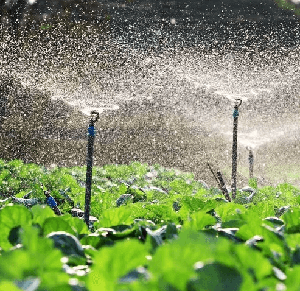
A misting system comprises nozzles, piping, a pressure regulator, and a controller. It works by distributing moisture evenly in your greenhouse by emitting tiny water droplets via the nozzles. Eventually, the water droplets usually turn to vapor to help bring down the high temperatures.
Alternatively, you can use a fogging system that produces micro-droplets of water to provide uniform and instantaneous evaporation. As a result, this ensures cooling across the entire structure. Now, to power both systems, you can use solar-charged batteries.
6. Roll-up side curtains
This solution works best if the side walls of your structure are straight. You can choose to install automated or manual roll-up side curtains. To automate the curtains, you simply use solar power energy.
As the name suggests, once you install these side curtains on your structure, you just roll them up when it’s hot. This allows heat within the greenhouse to escape and fresh outside air to get inside. But apart from the curtains, you can also mount roll-up door assemblies to maximize ventilation.
7. Solar-powered evaporative cooler
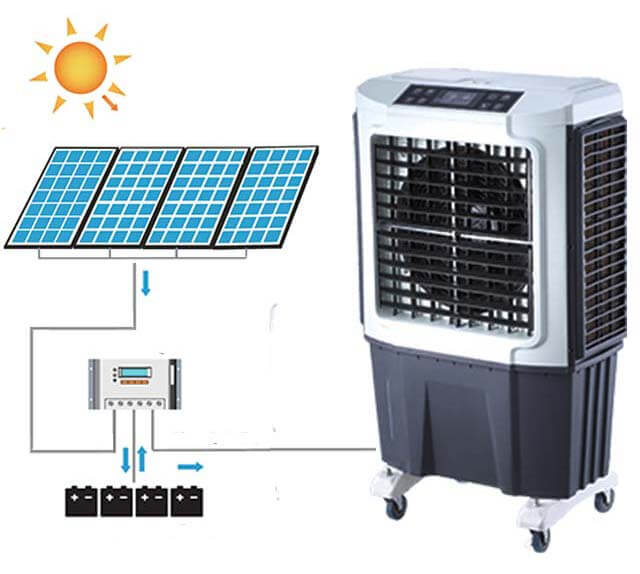
This system uses evaporation to cool the air in your greenhouse and can work 100% on solar power. The cooler features an evaporative pad and fan, which you must mount on opposite sides of the wall.
Typically, the fan helps draw air from outside via the evaporative pad. As air flows past the wet padding, the moisture evaporates, creating a cooling effect inside the structure. You can expect the system to cool your greenhouse as much as 10-20 degrees Fahrenheit.
8. Portable air conditioner
A portable air conditioning system is built to run on off-grid systems. The device sucks hot and humid air inside your greenhouse and pumps it outside. At the same time, it releases cool air back into the structure at different stages to keep the heat down.
When installing a portable air conditioner, you can choose either a single or a two-hose unit. Typically, a single-hose AC unit sucks in warm air and vents it using a single pipe. On the other hand, a two-hose air conditioner has a separate conduit for bringing in cool air and venting out hot air.
9. Watering plants
Plants can keep the landscape of your structure cool through transpiration. Because when your greenhouse gets hot, the plants usually discharge surplus water into the air via their leaves. Consequently, this helps cool the plants and your entire greenhouse.
The water your crops release into the air usually comes from the soil. So, with time, your plants may wilt due to a lack of water. This explains why you must water these plants as often as possible.
10. Growing large-leaved plants or deciduous trees
Another method of cooling your greenhouse without electricity is using plants with broad leaves. Some good examples include grapevine and fig trees. The large leaves provide shading for the soil while also serving as natural evaporative coolers to keep the structure cool.
Additionally, you could plant deciduous trees or plants such as maple, oak, and birch outside but near your greenhouse. These trees usually lose their leaves in the fall and grow new ones in the spring. Therefore, they can shade your structure from the scorching sun.
How To Keep Your Greenhouse From Getting Too Hot?
The first thing you must do is get a thermometer for monitoring the temperatures in your greenhouse. This way, you can accurately tell how hot the structure is inside.
Next, you must ensure your greenhouse has an adequate roof and side vents throughout because proper ventilation is everything. Keeping the doors open is another effective way to ensure your structure does not get too hot.
If you live in a hot area, you can consider installing the structure closer to trees. The trees will provide shading during the hottest time of the year and function like a natural greenhouse shade cloth.
Additionally, you can take advantage of prevailing winds by aligning your structure to the direction of the winds in the area during installation. This provides your greenhouse with automatic cooling.
FAQs
Enough with learning about the greenhouse basics. Let’s quickly look at commonly asked questions about cooling your structure without electricity.
What temperature is too hot for a greenhouse?
When the temperatures go beyond 85- 90 degrees Fahrenheit, the greenhouse tends to be too hot. This is because most plants require temperatures of 60 to 80 degrees Fahrenheit to flourish in the greenhouse. So, your structure may be too hot, even at 75 degrees Fahrenheit, depending on the plants you grow.
What happens if the greenhouse gets too hot?
Your plants will begin to wilt, and the edges may gradually change into brown color. Additionally, excessive heat may put your plants at a higher risk of pest infestation and diseases. As for the flowers, they may begin to fall off. Consequently, this can lead to lower yields and reduced crop quality.
How hot can a greenhouse get in the winter?
About 30 degrees Fahrenheit. However, this depends on many factors, such as your climate, structure design, and the amount of snow cover. Also, the type of materials the greenhouse is made of. For instance, if it’s constructed from plastic materials, it may not stay as hot as one made of glass.
Conclusion
Cooling your greenhouse using electricity for as long as necessary is not a cost-effective method. The good thing is there are several methods on how to cool a greenhouse without electricity. You could use vents, solar-powered fans, shading cloth, misting systems, or evaporative coolers.
Now, besides knowing how to cool your greenhouse, you should also learn how to keep it from getting too hot. Because if it gets too hot, your crops will be more prone to diseases and pests. Eventually, some of the plants may die.

